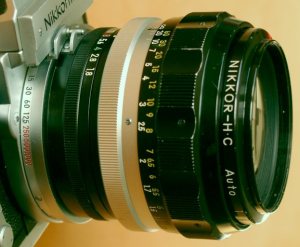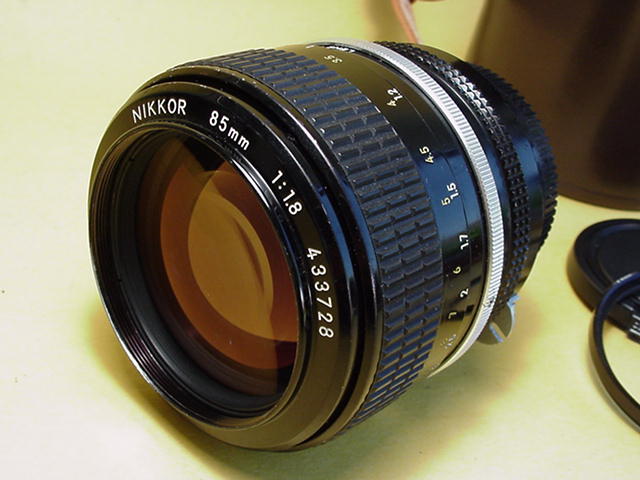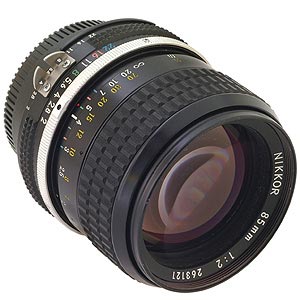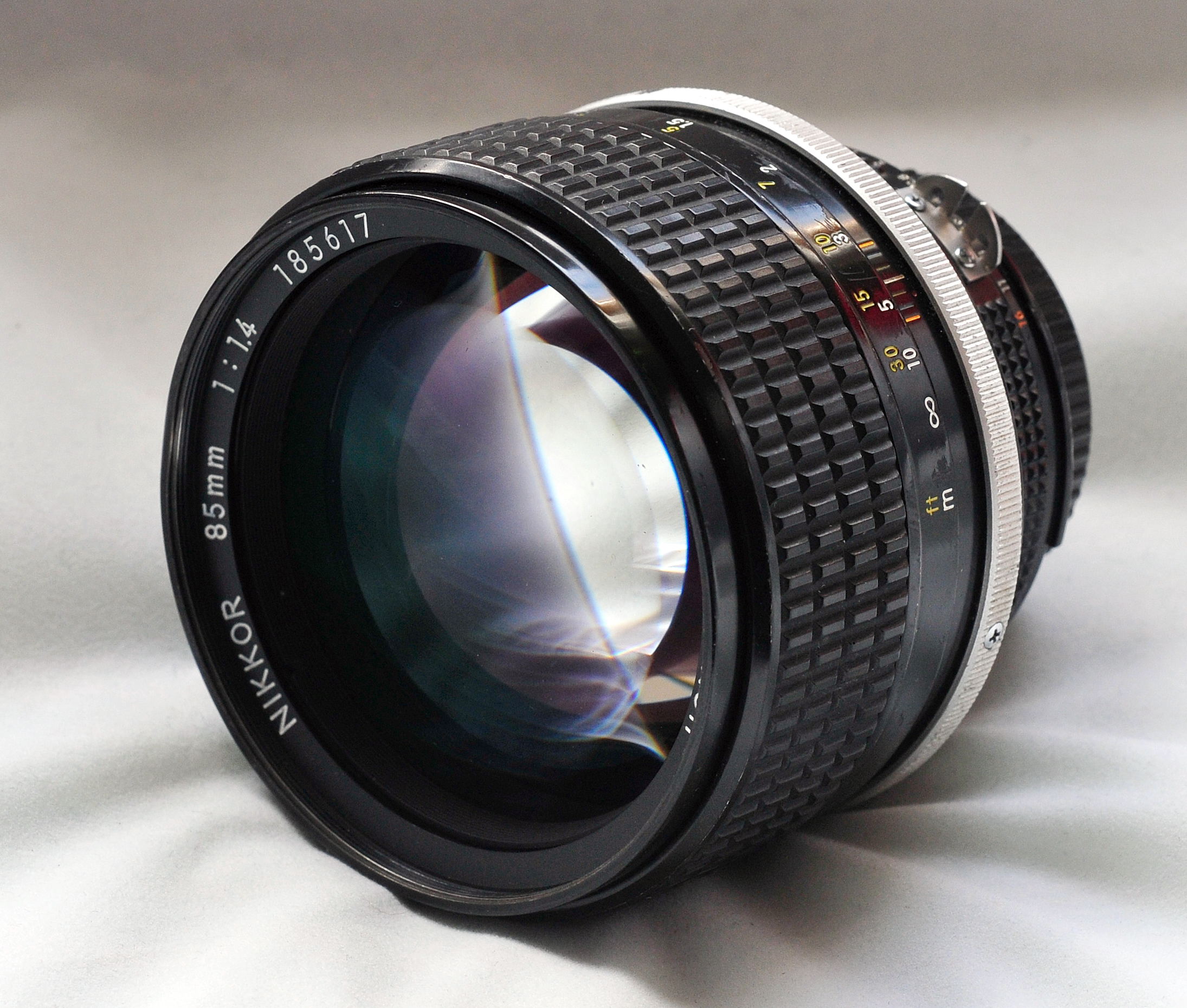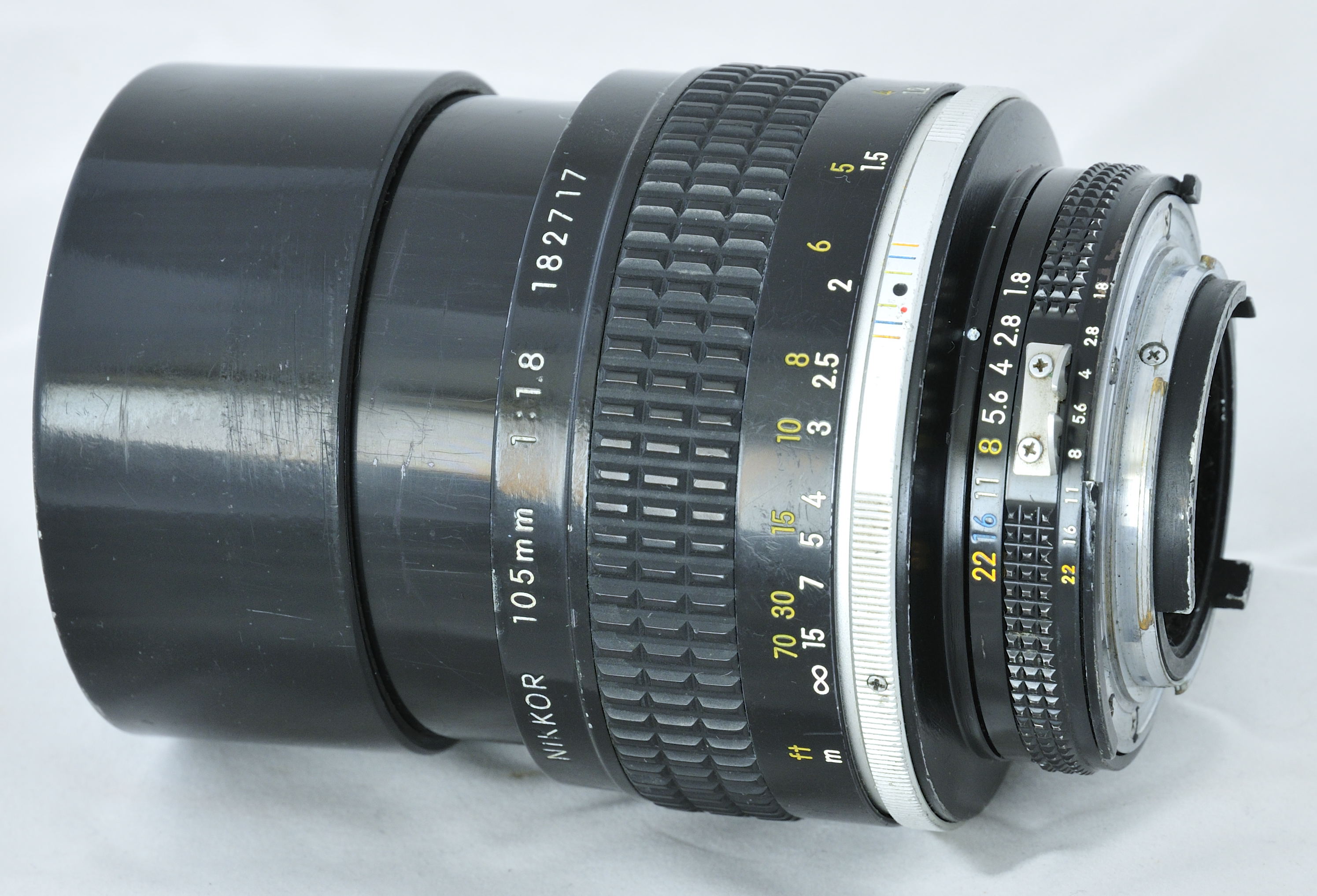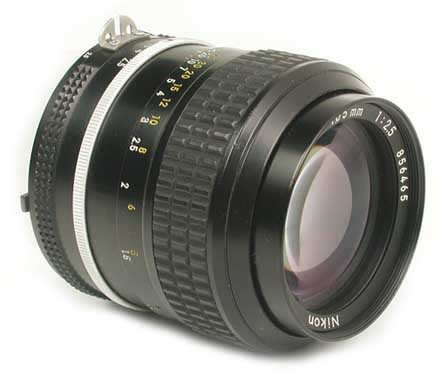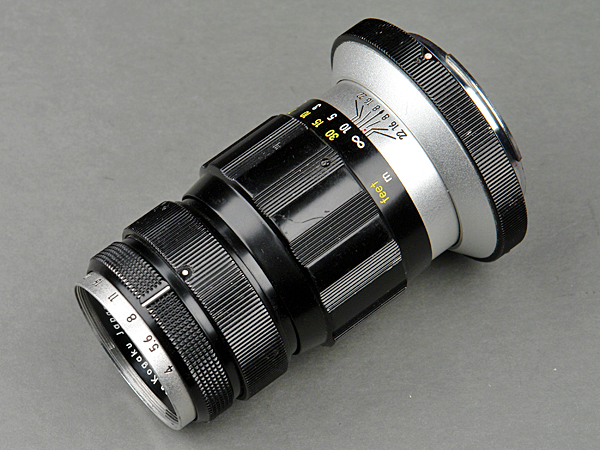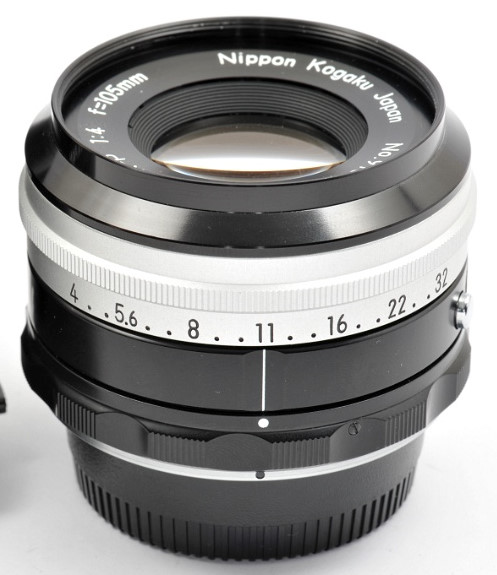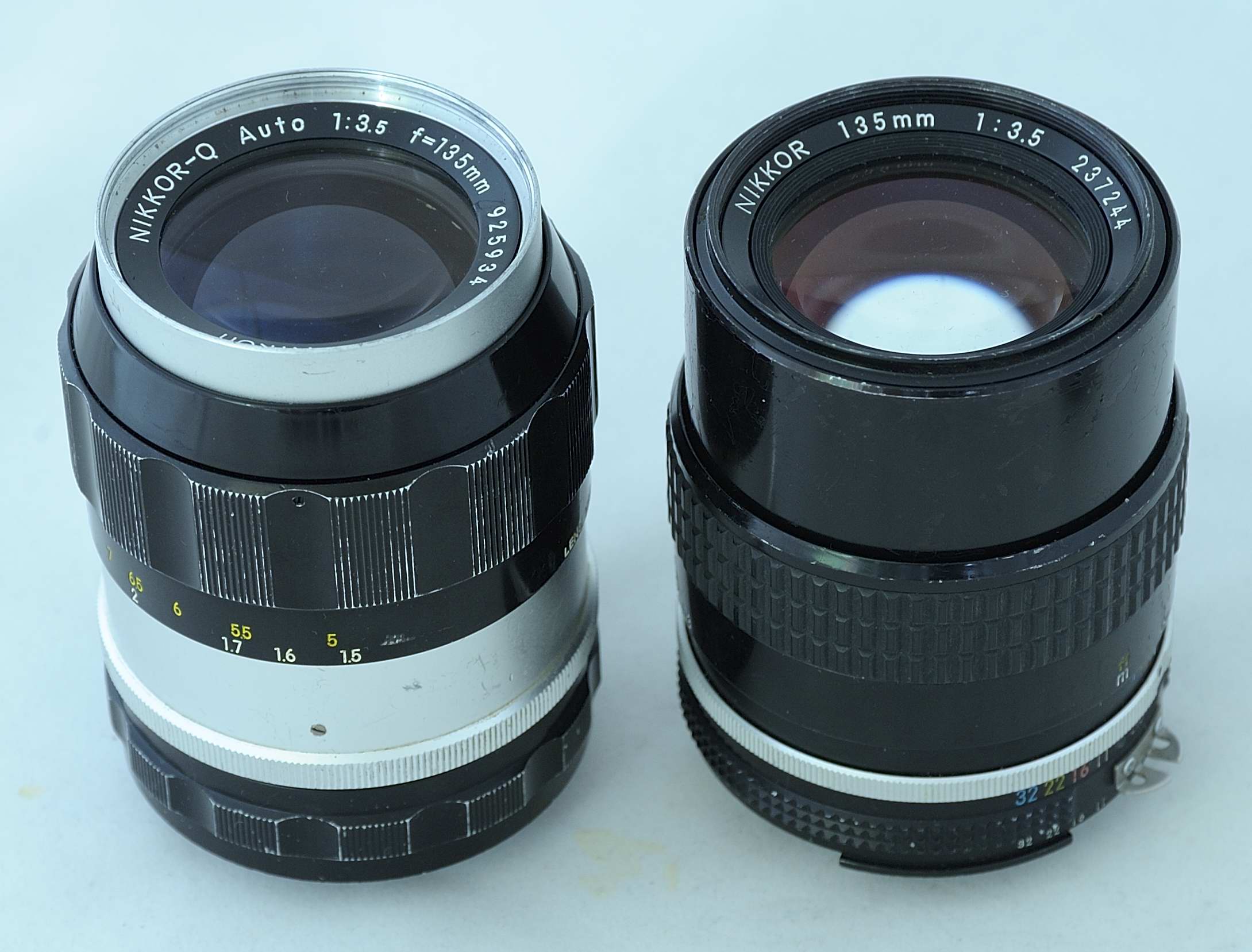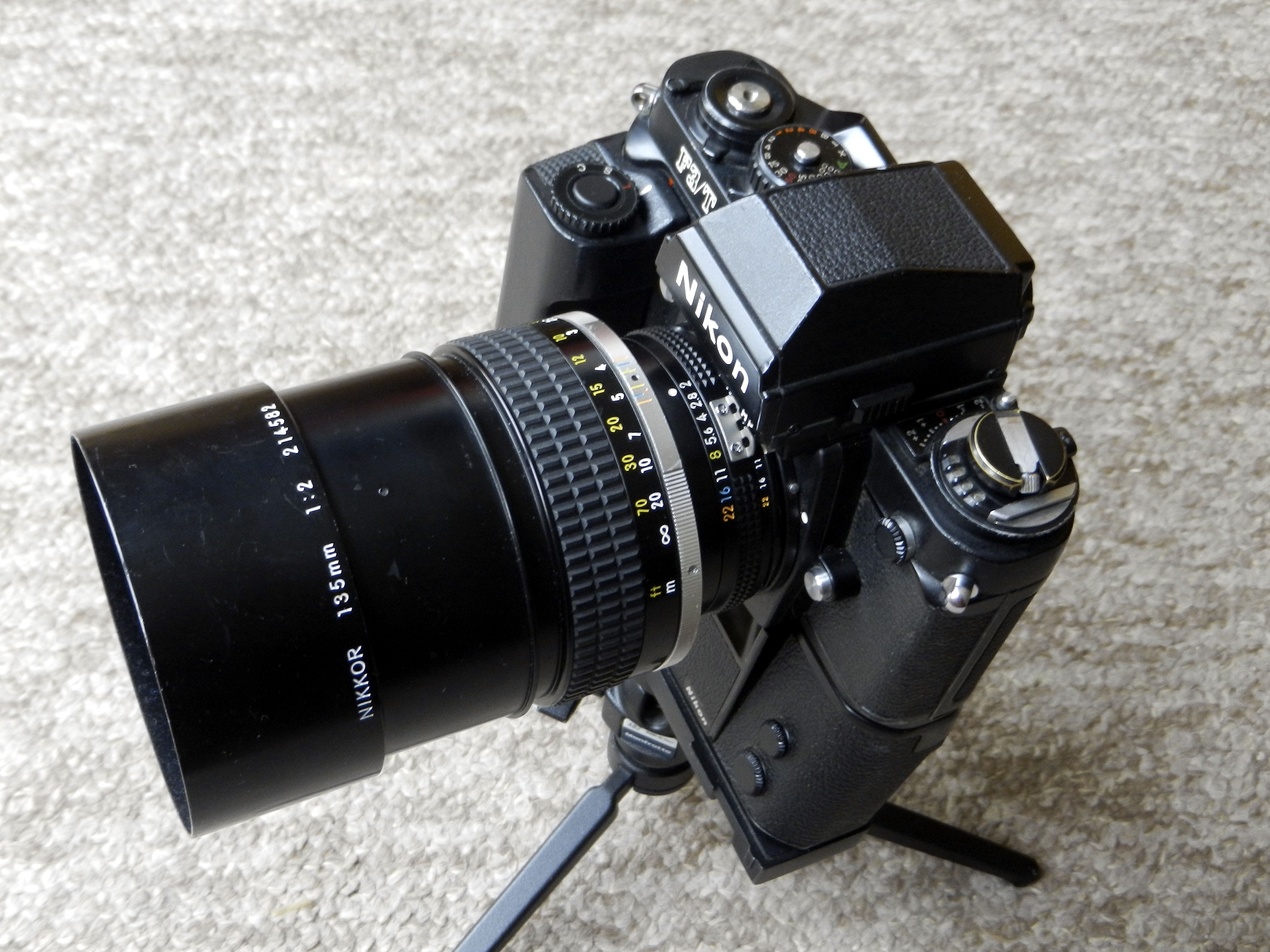Nikkor portrait lensesAs a producer of professional camera systems Nikon Corporation produced many lenses for specific demands, like close-ups and portrait photography. Through the years many lenses with various specifications were introduced. We consider a portrait lens a lens with a fixed focal length of approximately twice the focal length of a standard lens. Lenses made for a special purpose like micro-photography are not listed here. The Nikkor Series-E lenses in this range can be found in the respective chapter. Listing in chronological order.
Nikkor 1.8/85 mm.
The first version (Nikkor-H) of this wonderful and razor sharp lens was introduced in August 1964. It is a light lens with a rather simple optical construction of 6 elements in 4 groups. Aperture range is 1.8 - 22. A coated version (Nikkor-H.C) was presented in June 1974, quickly followed in June 1975 by a redesigned version (see below).
It now has the straight lens barrel with rubber grip. Of this lens there are no AI- or AIS-versions, although the last version can be converted to AI-mount. Because of its very short production period it is a rather rare lens. After a silent period of more than 12 years the lens appeared on the market in February 1988 as an AF-Nikkor with a slightly changed optical design (6 individual elements and an aperture range of 1.8 - 16). In March 1994 the AF-D-version was introduced. Both the manual and the autofocus are outstanding performers. Nikkor 2/85 mm.
In June 1977 this lens as an AI-version replaced the before mentioned manual focus lens. It has 5 individual elements in its optical construction and is about 100 gram lighter than its predecessor. In October 1981 the AIS-version was introduced. It is an underestimated lens as sales were not that high, but its performance is Nikon-alike. Even on a digital reflex camera an excellent portrait lens. Nikkor 1.4/85 mm.
This very fast portrait lens was introduced in September 1981. Its optical construction consists of 7 elements in 5 groups, aperture ranges from 1.4 - 16 and its weight is 620 gram. It is an outstanding performer for available light photography (e.g. theater). It can be used wide open without problems. Don´t use it at apertures smaller than f/8. This rather expensive lens was a good seller. That´s why Nikon decided to produce an AF-D-Nikkor in December 1995. This modern lens is of a totally redesigned optical construction: 9 elements in 8 groups, internal focusing and rounded aperture blades for the improvement of the non-sharp areas (aka bokeh). Filter size grew from 72 mm. to 77 mm. Its weight went down from 620 gram to 550 gram. 1.8/105 mm.
In September 1981 this magnificent lens was put on the market. This AIS-lens, weighing in at 580 gram, is a bit underestimated by professional photographers, or it suffered from the very competitive 1.4/85 mm. Wide open its performance is stunning (also on a digital reflex camera), despite the lack of the CRC-system. As with many fast lenses it should be used at small apertures. Because of the 5 individual elements flare and coma are almost absent. A rare and hard to find lens.
2.5/105 mm.
This lens belongs to the group of Nikkors that gave Nikon Corporation its reputation as manufacturer of excellent lenses. A very old design, calculated with an abacus somewhere in the early 1950´s, that proved to be THE standard of a portrait lens. The optical construction (5 elements in 3 groups) of the very first version, made for Nikon rangefinder cameras, remained nearly unchanged up to this century. Just a few years ago Nikon decided to stop the production of this very popular lens. The SLR-version (Nikkor-P) appeared together with the Nikon F in 1959. In February 1973 the optical construction underwent a minor change (5 elements in 4 groups = 2 cemented elements were separated). This version can be identified by its aperture range of 2.5 - 32. As many other Nikkors this lens got its straight barrel with rubber grip in May 1975, followed two years later (May 1977) by the AI-version (aperture down to 22). In October 1981 the AIS-version was introduced, which could be found in price lists up to 2004. The last versions featuring the Nikon Integrated Coating are probably the best, although it must be said that some modern Nikkor lenses (even zoom-Nikkors) outperformed this lens. 4/105
(courtesy Ching-Kuang Shene) Another lens made for Nikon rangefinder and SLR cameras, the Nikkor-T 4/10.5 cm.!! This very rare lens was introduced in early 1960 in both S- and F-mount. It is one of the rarest pre-set lenses Nikon ever produced. At the front ring the aperture have to be set manually and manual focusing down to 80 cm. There is no coupling mechanism for an automatic aperture. It has just 3 individual, a filter thread of 34.5 mm and weighing in at 230 gram. The lens disappeared from the market in 1961. It became a rare, forgotten, and not much sought-after lens.
(courtesy Richard de Stoutz) A second version of this lens was introduced in 1970 as the Bellows-Nikkor-P 4/105 mm. It can only be used mounted on a bellows. This extremely rare lens has a pre-set aperture, no distance scale and no focusing ring. Focusing has to be done with the bellows. It has 5 elements in 4 groups and its weight is 230 gram. There are two versions known: one with the lens data on the side of the front ring and one with these data inside the front ring (see above) . 3.5/135 mm.
Also this lens already existed in the rangefinder era. It was designed in early 1950 as Nikkor-Q-C 3.5/13.5 cm. The SLR-version was introduced in 1959 as one of the lenses for the new Nikon F single lens reflex camera. Until 1977 this lens remained unchanged. Its optical construction consists (since 1950!) of 4 elements in 3 groups with an aperture range of 3.4 - 22 (in May 1969 extended to 32). In May 1977, at the start of the Nikon AI-era, this lens got a totally redesigned outfit. A straight barrel with rubber grip housing an optical construction of 4 individual elements, all coated with the famous Nikon Integrated Coating. An AIS-version was introduced in April 1982. One year later it died a gentle death. For photographers and collectors with a small budget the last version is a cheap find on the secondhand market, though still a very nice lens. 2.8/135 mm. Introduced in December 1965 this lens (Nikkor-Q 2.8/135 mm.) was relatively fast and modern, as it had a built-in shade, straight lens barrel with rubber grip. It only has 4 individual elements, giving crisp images without any flare or ghosting. In March 1974 it received a better coating and in March 1975 a new lens barrel. In March 1977 the AI-version with 5 elements in 4 groups was introduced. The AIS-version - presented in December 1981 - remained unchanged until 2005, when Nikon announced to stop the production of most manual focus lenses. 2/135 mm.
Two lenses with this technical specification exist. The Nikkor 2/135 mm. was introduced in December 1975 as a relatively fast short tele-lens. In 1977 it was changed into an AI-version and in December 1981 into an AIS-version. This lens´ optical construction of 6 elements in 4 groups wasn´t altered during its entire production period, which ended early this century. This fast and heavy (860 gram) lens is an excellent performer, especially in low-light conditions. In April 1991 Nikon introduced the AF-DC-Nikkor 2/135 mm. Like the 2/105 mm. lens mentioned before, this lens features the defocus control system. If focused on a certain subject via de defocus ring the foreground or background can be turned out of focus. This fast lens features rear focusing too. The optical design (7 elements in 6 groups) differs from its manual counterpart. In December 1995 a D-chip was added to the lens; ideal for modern flash photography.
An attentive reader may conclude that Nikon Corporation designed optical schemes in its early days that lasted up to date. It may be one indication of the quality of Nikon´s engineering that made Nikon one of the best lens constructors of this world.
|
